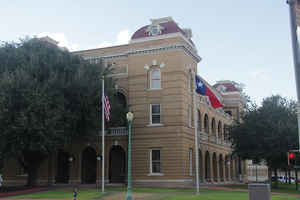Texas Counties
Texas is divided into two hundred and fifty-four counties, more than any other state. Texas was originally divided into municipalities, a unit of local government under Spanish and Mexican rule. When the Republic of Texas gained its independence in 1836, there were 23 municipalities, which became the original Texas counties. Many of these would later be divided into new counties. The most recent county to be created was Kenedy County in 1921. The most recent county to be organized was Loving County in 1931Webb County, Texas
Webb County Education, Geography, and History

Webb County is a county located in the state of Texas. Based on the 2010 census, the population was 250,304. Its county seat is Laredo. The
county was named after James Webb, who served as Secretary of the Treasury, Secretary of State, and Attorney General of the Republic of Texas,
and later judge of the United States District Court following the admission of Texas to statehood. By area, Webb County is the largest county
in South Texas and one of the largest in the state. It is northeast from the Mexican border.
Webb County comprises the Laredo metropolitan area.
Etymology - Origin of Webb County Name
James Webb, who served as secretary of the Treasury, secretary of State, and Attorney General of the Republic of Texas, and later United States District Judge in the State of Texas
Demographics:
County QuickFacts: CensusBureau Quick Facts
Webb County History
Meanwhile, even before the Treaty of Guadalupe Hidalgo assigned the Nueces Strip to Texas, legislators in Austin included it in the new jurisdiction of Nueces County in 1846; in January 1848 the Texas legislature established Webb County. Its county seat is Laredo. Webb County was named after James Webb, who served as secretary of the Treasury, Secretary of State, and Attorney General of the Republic of Texas, and later United States District Judge in the State of Texas. Webb County is the largest county in South Texas by area.
Webb County was split into two counties in 1856. Encinal County was established on 1 February 1856 and was to consist of the eastern portion of Webb County, Texas. The county was never organized and was finally dissolved on 12 March 1899. The Encinal territory was absorbed into Webb County.
Handbook of Texas Online
Between 1836 and 1848 the area that is now Webb County was part of the disputed strip of land between the Rio
Grande and the Nueces River claimed by both Mexico and Texas. Though Laredo was briefly designated capital of the
short-lived Republic of the Rio Grande during a federalist rebellion led by
Antonio Canales, residents remained primarily loyal to the Republic of Mexico. Consequently, the area was raided on
several occasions by Texans seeking revenge, adventure, or booty. Erastus (Deaf) Smith
led an 1837 expedition that stopped just short of an attack on Laredo, for example, and an expedition led by
Alexander Somervell in 1842 captured and plundered the town. The area was
brought more firmly into the orbit of the United States during the Mexican War
of 1845-48. Laredo was captured in 1846 and held for the duration of the war. Meanwhile, even before the Treaty of
Guadalupe Hidalgo assigned the Nueces Strip to Texas, legislators in Austin
included it in the new jurisdiction of Nueces County in 1846; in January 1848 the Texas legislature established Webb
County, which was named in honor of Judge James Webb. Despite the hopes of
prominent Laredo citizens, who petitioned to remain part of Mexico, the area was formally incorporated into the
United States in May 1848. Worried about their future after annexation, many
residents moved to the Mexican side of the river and established Nuevo Laredo; others moved into the surrounding
Texas countryside. Suspicions that land titles would not be respected under the new government were soon put to
rest. The Bourland-Miller Commission, which inspected Spanish and Mexican land titles in South Texas, proved to be
fair and impartial in its assessment of land records. Local landholders therefore found it easier to accommodate
themselves to the new political situation. Federal soldiers stationed at Fort McIntosh patrolled the area for
bandits and hostile Indians More at
John Leffler and Christopher Long, "WEBB COUNTY," Handbook of Texas Online (http://www.tshaonline.org/handbook/online/articles/hcw05),
accessed January 24, 2016. Uploaded on June 15, 2010. Published by the Texas State Historical Association.
Geography: Land and Water
As reported by the Census Bureau, the county has a total area of 3,376 square miles (8,743 km2), of which,
3,357 square miles (8,694 km2) of it is land and 19 square miles (48 km2) of it (0.55%) is water.
Neighboring Counties
Bordering counties are as follows:
- Dimmit County (north)
- La Salle County (north)
- Duval County (east)
- Jim Hogg County (southeast)
- Zapata County (south)
- Maverick County (northwest)
- Guerrero, Coahuila, Mexico (west)
- Hidalgo, Coahuila, Mexico (west)
- Anahuac, Nuevo Leon, Mexico (west)
- Nuevo Laredo, Tamaulipas, Mexico (southwest)
Education
Three school districts serve Webb County:
Laredo Independent School District
United Independent School District
Webb Consolidated Independent School District
Prior to 1994 Webb CISD served only Bruni and Oilton. Mirando City Independent School District served the community of Mirando City from 1923
to 2005. Prior to 1994 all Mirando City children attended Mirando City ISD schools. After the spring of 1994, Mirando City High School
closed.[39] Therefore, from the fall of 1994 to July 1, 2005, WCISD served high schoolers from Mirando City while Mirando Elementary School in
the Mirando City ISD served pupils from kindergarten through 8th grade. On May 9, 2005 the Texas Education Agency ordered the closure of
Mirando City ISD. The district closed on July 1, 2005, and all students were rezoned to Webb CISD schools.
The private Holding Institute is a former United Methodist boarding school operating as a downtown Laredo community center







